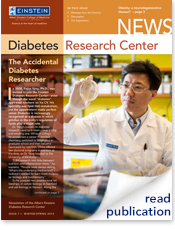

FULL STORY
The Accidental Diabetes Researcher
In 2008, Fajun Yang, Ph.D., was invited to join the Einstein Diabetes Research Center — even though the word "diabetes" appeared nowhere on his CV. His specialty was lipid (fat) metabolism, yet the appointment made perfect sense: Diabetes is increasingly recognized as a disease in which glitches in the body's regulation of lipids play a major role.

Fajun Yang, Ph.D.Dr. Yang's journey to diabetes research — and to Einstein — was a long and winding one. While in college, he envisioned a career in applied chemistry, switched to biophysics in graduate school and then became fascinated by nutrition. China offered few doctoral programs in nutrition at the time, so Dr. Yang headed to the University of Kentucky.
"I did research into links between nutrition and inflammation there," he explains. "People were always asking, 'What's the underlying mechanism?' I realized I needed to learn more molecular biology and biochemistry."
So he pursued two postdoctoral fellowships, in cancer biology at Stanford and cell biology at Harvard. Along the way, he mastered techniques for deciphering the regulation of gene expression, with a focus on genes involved in lipid metabolism. He was now an ideal candidate for diabetes research.

This article was originally published in the Winter/Spring 2013 Diabetes Research Center newsletter"It's no coincidence that the prevalence of diabetes is directly proportional to the prevalence of obesity," says Dr. Yang, now an assistant professor of medicine (endocrinology) and of developmental and molecular biology at Einstein. "Lipid metabolism has intimate relationships with insulin resistance, where insulin can't do its normal job of lowering blood sugar levels. We also know that dysregulation of lipid balance can cause obesity and lead to the cardiovascular complications of diabetes. So it's important to understand the molecular mechanisms involved in regulating fat metabolism."
Dr. Yang is investigating those mechanisms in his study of a protein called SREBP-1c. This protein controls key genes involved in making fat. Previous studies have found that abnormally high levels of SREBP-1c are linked to overweight and to type 2 diabetes, but just how is poorly understood.
To better understand that link, Dr. Yang is investigating SREBP-1c's interaction with CDK8, an enzyme that curbs fat production by keeping active SREBP-1c levels in check. With funds from the American Diabetes Association, Dr. Yang is trying to learn more about how these two proteins are related, with the long-term goal of seeing whether influencing their molecular interaction could help prevent or treat type 2 diabetes.
In a second study, funded by the National Institute of Diabetes and Digestive and Kidney Diseases, Dr. Yang is focusing on another SREBP-1c regulator called SIRT1, a so-called longevity gene. "As we age, active SREBP-1c becomes more abundant in cells, causing nonalcoholic fatty liver disease, in which the liver accumulates fat," says Dr. Yang. One reason for this is that SIRT1 — which normally puts the brakes on active SREBP-1c — gets less expressed in old age, he explains. "This led me to ask, what upstream signals regulate SIRT1?" One such signal, Dr. Yang has found, is an enzyme called LSD1. His next step is to gain a fuller understanding of how SIRT1 and LSD1 interact to regulate SREBP-1c, which in turn regulates lipid metabolism.
If diabetes can be cured by figuring out these molecular pathways, then Dr. Yang is the man for the job. After all, he's traveled an impressively eventful path already.
Posted on: Wednesday, October 2, 2013

Tablet Blog